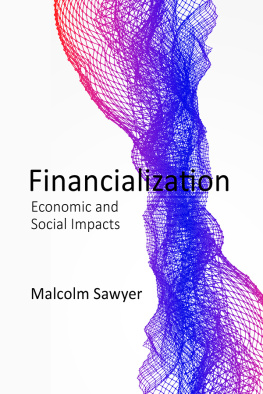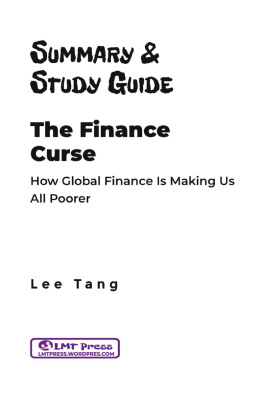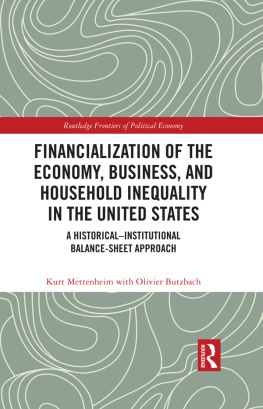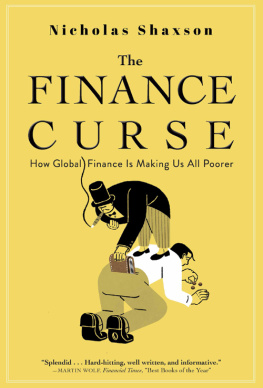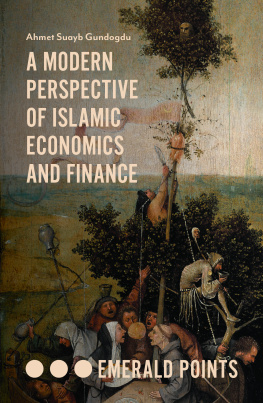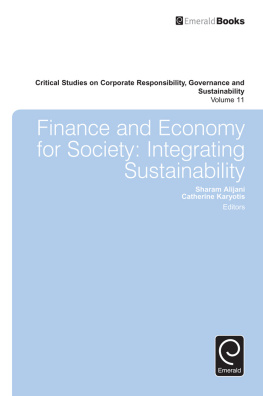FINANCIALIZATION
FINANCIALIZATION
Economic and Social Impacts
MALCOLM SAWYER

Malcolm Sawyer 2022
This book is copyright under the Berne Convention.
No reproduction without permission.
All rights reserved.
First published in 2022 by Agenda Publishing
Agenda Publishing Limited
The Core
Bath Lane
Newcastle Helix
Newcastle upon Tyne
NE4 5TF
www.agendapub.com
ISBN 978-1-78821-230-4
British Library Cataloguing-in-Publication Data
A catalogue record for this book is available from the British Library
Typeset by Newgen Publishing UK
Printed and bound in the UK by CPI Group (UK) Ltd, Croydon, CR0 4YY
CONTENTS
Most of the analysis and lines of arguments pursued in this book arose from research associated with the research project on Financialisation Economy Society and Sustainable Development (FESSUD). I was the principal investigator of this European Union-funded research project, which ran for five years from December 2011 to November 2016 and was in preparation for two years prior to the start. This project was funded at 8 million by the EU and involved partners from 14 academic institutions and one non-governmental organization (NGO). I acknowledge, with thanks, the EU funding, which enabled many scholars to pursue wide-ranging research on financialization and its widespread impacts on the economy, society and the environment. The enthusiasm, commitment and scholarship of those involved in the FESSUD project were always a great support and have contributed to the research ideas in this book. I, though, take responsibility for the ideas expressed here.
I am grateful to Alison Howson for enthusiastic support for this book, her comments and her patience while it took so long to complete.
My greatest support has come, as it has for over half a century, from my wife Jan, for which I express my love and great thanks.
Malcolm Sawyer
Figures
Tables
The financial system, the financing and funding of production and investment in business through banks, financial institutions and stock markets have long been essential features of capitalist economies. The role of the financial sector has often been viewed in terms of supporting what may be termed the real economy, funding the establishment and expansion of firms, the provision of liquidity and the payments system. There have always been debates over the nature of the relationship between the financial system and the real economy, and how well the financial system serves the real economy.
The global financial crises of 200709 (hereafter GFC) followed three decades of intense financialization, which will be referred to below as the present era of financialization. The plural crises is used here to indicate that there were major banking and financial crises in Iceland, Ireland, the UK and USA, which occurred around the same time and reached their height in the autumn of 2008. Although there were similar causes for these national financial crises there were also differences, and there were interactions and overlaps between them. The effects of these crises were exacerbated and spread through contagion notably through effects of possession of toxic assets on banks balance sheets and through recessionary impacts on international trade.
The initial signs of financial difficulties came in August 2007 with problems in the inter-bank market and then the financial difficulties at Northern Rock in the UK. The collapse of Bear Stearns was a further sign of crisis, which intensified in September/October with the failure of Lehman Brothers followed by many other financial institutions being bailed by governments. In Iceland, three major banks collapsed in October 2008 and control was taken by the Financial Supervisory Authority. In Ireland, one major bank (Anglo Irish) was nationalised in January 2009 and two (Allied Irish Bank, Bank of Ireland) were bailed out by the government in February 2009. In the UK, there were major bailouts of Royal Bank of Scotland (RBS), HBOS and Lloyds TSB in October 2008, with the UK government acquiring initially a 43 per cent stake in Lloyds Banking Group and 82 per cent in RBS. There was also a banking crisis in Belgium, with its two largest banks, Fortis and Dexia, facing severe problems.
The collapse of Lehman Brothers in September 2008 triggered a broader run on the global financial system and signalled a systemic crisis (although difficulties in the financial system had been emerging during the previous 12 months). The then head of the World Bank, Christine Lagarde (), writing on the tenth anniversary of the collapse of Lehman Brothers, indicated that there had been a banking crisis in 24 countries and economic activity was still below trend in most countries.
The GFC of 200708 provided stark evidence of the global nature of the financial system and the interconnections between national financial systems. It threw into sharp relief the instabilities of the financial system, although the GFC was the latest in a series of financial crises in this era of financialization. Previous substantial ones include the Mexico crisis of 1994, East Asian crisis of 1997 and the Russian crisis of 1998. Indeed, the era of financialization since 1980 has been characterized by recurrent financial crises, with over 450 recorded since 1970, of which 151 were banking crises and the others currency and sovereign debt crises (Laeven & Valencia .
The GFC drew to public attention that the rapid expansion of the financial sector had involved credit booms, the development of risky financial assets through securitization and property price booms, all of which were unsustainable and ended in a bursting of the boom. This book seeks to focus on the processes within the economy and the world of finance that underlie that incident and are still prevalent today long after the shock that brought the actions of the often mysterious world of the dark arts of finance into sharp relief.
Financialization, meaning the expansion of finance and financial institutions, has been a set of ongoing processes in industrialized capitalism for the past 200 years. Despite the crises, bubbles and boom-and-bust cycles of economic growth, a cursory look at the world shows the continuing economic, social and political power and influence of finance and the financial sector. At the personal level, our own involvement with finance and financial institutions, as compared with that of our parents or our grandparents generations, illustrates the level of change. Only a few decades ago, individuals would largely use cash to make their purchases, would shun debt and would own few financial assets. Since the 1960s, there has been the rapid growth of the use of credit cards, of payments by cheque and now debit card (rather than cash), the growth of various forms of consumer debt and, more generally, household engagement with financial assets and liabilities. At the global level, the expansion of finance and financial institutions has, in the past two or three decades, been experienced in almost every country of the world. The flows of finance and funds between countries and the operations of global financial markets are yet another dimension of the processes of financialization.
It is not only the economic importance of the financial sector that has grown, but also the social and political power of finance and the financial system. Financial institutions are notable contributors to political campaigns, particularly in the USA, and consequently strongly influence and indeed constrain the political agenda. Finance has increasingly penetrated our social life; as individuals we are connected into the financial system in real-time. Most of us can now bank using our phones, we access credit at the checkout to buy groceries, we take out loans for houses and education and we save for pensions. Our parents and grandparents, only 50 or 100 years ago, would have been paid in cash, with little if any access to formal banking, few owned their own home and hire purchase and credit cards were non-existent.

